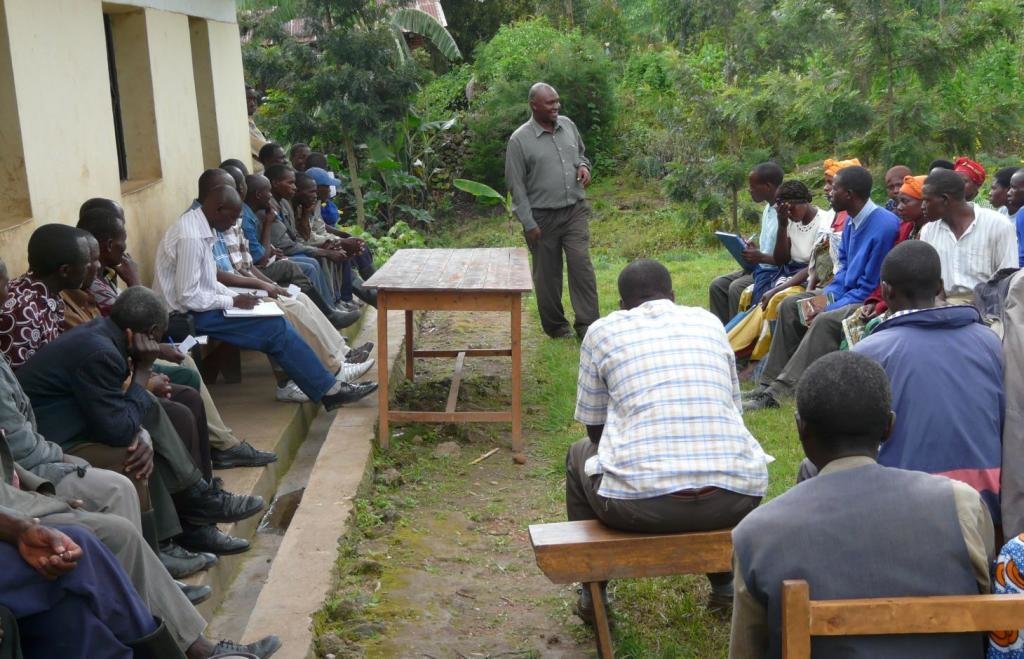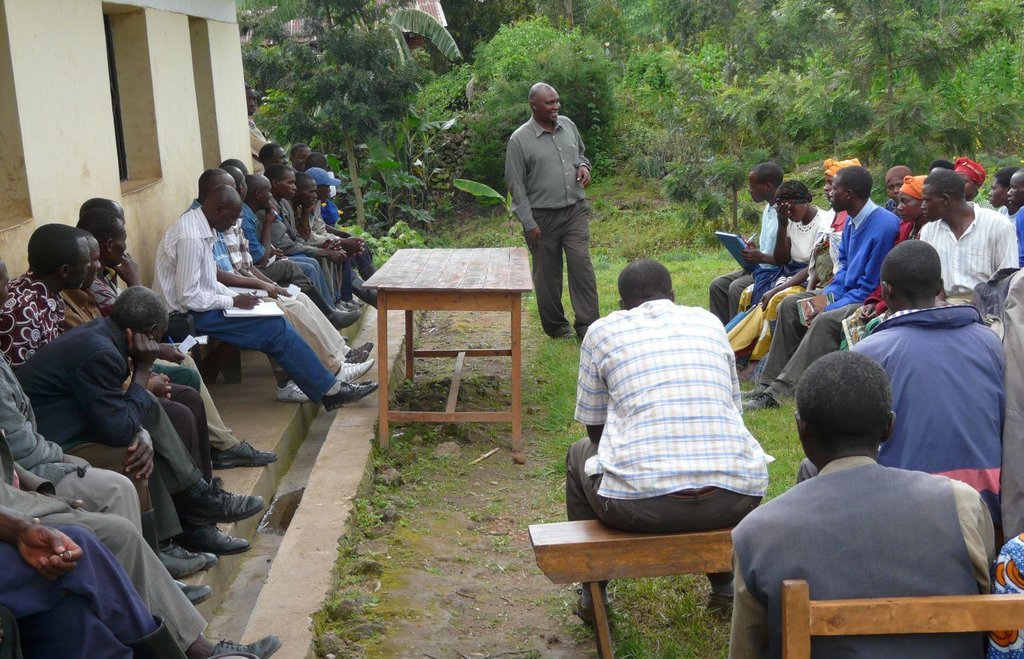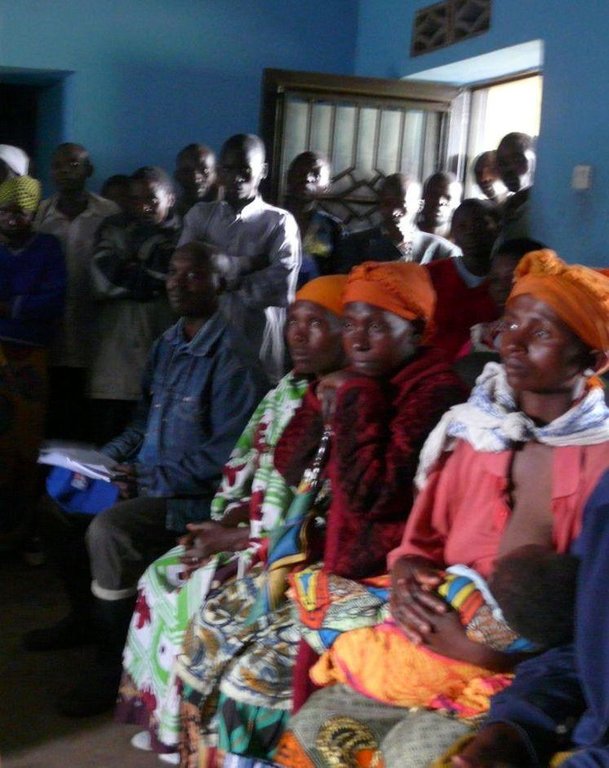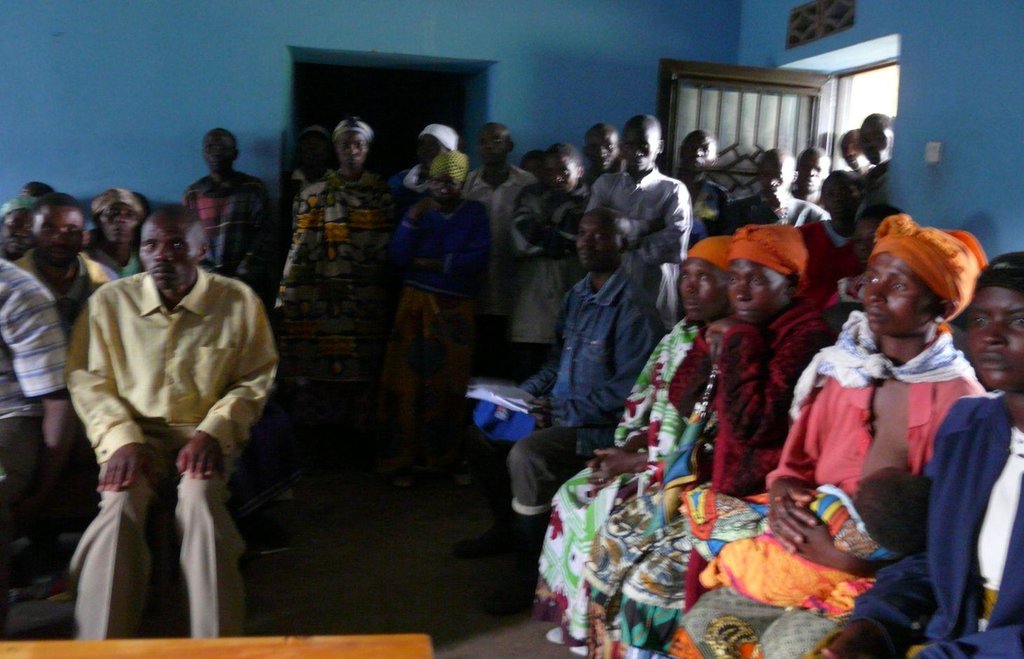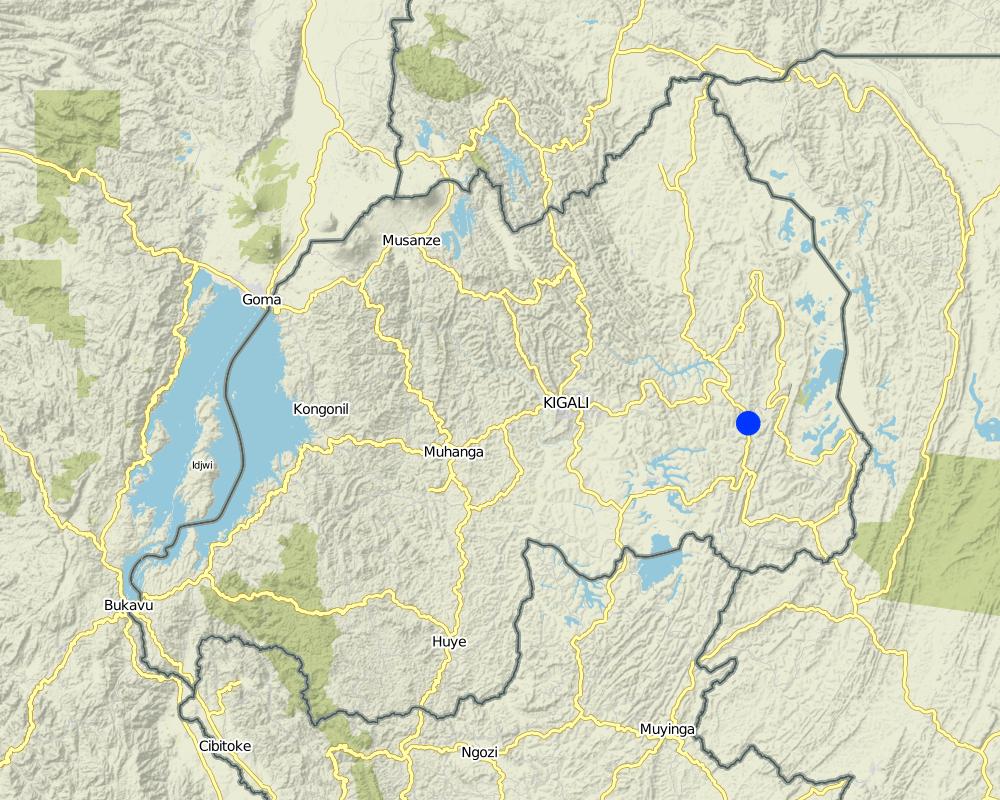Participatory approach [Ruanda]
- Criação:
- Atualização:
- Compilador/a: Desire Kagabo
- Editor: –
- Revisor: David Streiff
Ubufatanye bwinzego zose
approaches_2584 - Ruanda
Veja as seções
Expandir tudo Recolher tudo1. Informação geral
1.2 Detalhes do contato das pessoas capacitadas e instituições envolvidas na avaliação e documentação da abordagem
Especialista em GST:
Especialista em GST:
Muligirwa MULIGIRWAEmmanuel
Nome do projeto que facilitou a documentação/avaliação da Abordagem (se relevante)
The Transboundary Agro-ecosystem Management Project for the Kagera River Basin (GEF-FAO / Kagera TAMP )Nome da(s) instituição(ões) que facilitou(ram) a documentação/avaliação da Abordagem (se relevante)
Food and Agriculture Organization of the United Nations (FAO) - ItáliaNome da(s) instituição(ões) que facilitou(ram) a documentação/avaliação da Abordagem (se relevante)
Rwanda Agriculture Board (Rwanda Agriculture Board) - Ruanda1.3 Condições em relação ao uso da informação documentada através de WOCAT
Quando os dados foram compilados (no campo)?
06/05/2014
O/a compilador/a e a(s) pessoa(s) capacitada(s) aceitam as condições relativas ao uso de dados documentados através da WOCAT:
Sim
1.4 Referência ao(s) questionário(s) sobre tecnologias da GST
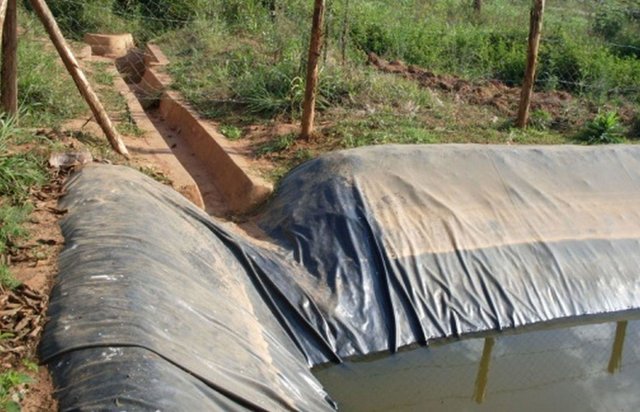
Lining geomembrane plastics for water harvesting and storage [Ruanda]
Lining geomembrane plastic for water harvesting and storage is a rainwater harvesting technique used by land users to collect rain water or runoff from a concave watershed to a common well-structured plastic-lined pond for agricultural, domestic and other use.
- Compilador/a: Iwona Piechowiak
2. Descrição da abordagem de GST
2.1 Descrição curta da abordagem
This approach is a contribution of different stakeholders and land users in the identification and resolution of a particular crop land problems, which implicate at the end different stage of intervention by all stakeholders to resolve the problem.
2.2 Descrição detalhada da abordagem
Descrição detalhada da abordagem:
Aims / objectives: The main goal of the approach is to plan and implement land management activities with villagers in such a way that sustainability is ensured. The specific objectives of the project are to:
(1) increase the capacity of the villagers to design, implement and self-evaluate Soil and water management activities.(2) improve crop production by limiting the effect of dry season during the critical stage of crop growth at the beginning of dry season.
Methods: This approach is integral to the Ministry of Agriculture and Animal Husbandry(MINAGRI) through a long-term project, which was initiated in 2005 and has been financed mainly by the government, with two different part of intervention of farmers which can be a voluntary participation and contributions of the local population or based on food for work.
Stages of implementation: Project extension work is carried out by facilitators from MINAGRI and consists of awareness raising and demonstration.
Problem identification and planning of activities takes place in village meetings. The local land users are supported by MINAGRI personnel who also provide technical and other facilities assistance during the implementation of Soil and Water Conservation measures
2.3 Fotos da abordagem
2.5 País/região/locais onde a abordagem foi aplicada
País:
Ruanda
Região/Estado/Província:
East
Especificação adicional de localização:
Kayonza
Comentários:
The area is not well known it is approximately determined by land users and local authorities.
Map
×2.6 Datas de início e término da abordagem
Indique o ano de início:
2005
2.7 Tipo de abordagem
- local government, diferents stakeholders and land user.
2.8 Principais metas/objetivos da abordagem
The Approach focused mainly on SLM with other activities (Reduce sedimentation and irrigation)
Design, test and disseminate alternative technologies adapted to local conditions - strengthen local knowledge of soil and water management measures.
The SLM Approach addressed the following problems: The lack of appropriate ways to develop sustainable technologies to remedy loss of runoff water and poor crop growth in the context of low-input agriculture on gentle undulating land in water scarce areas with an absence of soil conservation measures.
2.9 Condição que propiciam ou inibem a implementação de tecnologia/tecnologias aplicada(s) segundo a abordagem
Disponibilidade/acesso a recursos e serviços financeiros
- Inibitivo
Water harvesting is considered expensive due to material (mainly laying plastic sheet) and labour cost.
Treatment through the SLM Approach: Identification of a low-cost water harvesting measure, which can be implemented during the off-season. Cost-benefit analysis.
Conhecimento sobre GST, acesso a suporte técnico
- Inibitivo
Difficulty in tilling the land when water harvesting structures are in place.
Treatment through the SLM Approach: Integrating new technologies and local knowledge of farmers about the market, into growing more profitable crops (cash crops).
3. Participação e papel das partes interessadas envolvidas
3.1 Partes interessadas envolvidas na abordagem e seus papéis
- Usuários de terra/comunidades locais
Decision making
- Organizações comunitárias
- Especialistas em GST/ consultor agrícola
- Governo local
- Governo nacional (planejadores, responsáveis pelas decisões)
- Organização internacional
3.2 Envolvimento do usuários de terra/comunidades locais nas diferentes fases da abordagem
| Envolvimento do usuários de terra/comunidades locais | Especifique quem estava envolvido e descreva as atividades | |
|---|---|---|
| Iniciação/motivação | Participativo | |
| Planejamento | Participativo | |
| Implementação | Apoio externo | |
| Monitoramento/avaliação | Participativo | |
| Research | Participativo |
3.4 Decisão sobre a seleção de tecnologia/tecnologias de GST
Especifique quem decidiu sobre a seleção de tecnologia/tecnologias a serem implementadas:
- Principalmente especialistas em GST, após consulta com usuários da terra
Explique:
Decision were mad by land users and stakeholders.
Decisions on the method of implementing the SLM Technology were made by mainly by SLM specialists with consultation of land users
4. Suporte técnico, reforço das capacidades e gestão do conhecimento
4.1 Reforço das capacidades/ formação
Foi oferecida formação aos usuários da terra/outras partes interessadas?
Sim
Especifique quem foi capacitado:
- Usuários de terra
- Equipe de campo/consultores
Tipo de formação:
- Áreas de demonstração
4.2 Serviço de consultoria
Os usuários de terra têm acesso a um serviço de consultoria?
Sim
Especifique se foi oferecido serviço de consultoria:
- nas áreas dos usuários da terra
Descreva/comentários:
Advisory service is quite adequate to ensure the continuation of land conservation activities; Land users are 100% willing to upscale the technology but they are financially not strong enough and unstable.
4.3 Fortalecimento da instituição (desenvolvimento organizacional)
As instituições foram fortalecidas ou estabelecidas através da abordagem?
- Não
4.4 Monitoramento e avaliação
Monitoramento e avaliação são partes da abordagem?
Sim
Comentários:
bio-physical aspects were ad hoc monitored by government through observations
bio-physical aspects were regular monitored by government through measurements
technical aspects were ad hoc monitored by government through observations
technical aspects were regular monitored by government through measurements
socio-cultural aspects were ad hoc monitored by government and land users through observations
no. of land users involved aspects were regular monitored by government and land users through measurements
management of Approach aspects were regular monitored by government through observations
There were no changes in the Approach as a result of monitoring and evaluation
There were few changes in the Technology as a result of monitoring and evaluation: Land users are trying to organise themselves to implement the technology although it is expensive.
4.5 Pesquisa
A pesquisa foi parte da abordagem?
Sim
Especifique os tópicos:
- Sociologia
- Economia/Marketing
- Tecnologia
Dê mais detalhes e indique quem realizou a pesquisa:
Research was carried out on-farm
5. Financiamento e apoio material externo
5.1 Orçamento anual para o componente de GST da abordagem
Caso o orçamento exato seja desconhecido, indique a faixa:
- 10.000-100.000
Comentários (p. ex. principais fontes de recursos/principais doadores):
Approach costs were met by the following donors: government: 40.0%; international non-government: 40.0%; local government (district, county, municipality, village etc): 15.0%; local community / land user(s): 5.0%
5.2 Apoio financeiro/material concedido aos usuários da terra
Os usuários da terra receberam apoio financeiro/material para a implementação de tecnologia/tecnologias?
Sim
Caso afirmativo, especifique tipo(s) de apoio, condições e fornecedor(es):
Care international provided funds (food for work) and the local government provided some equipments (plastic sheets) research staffs and means and training.
5.3 Subsídios para entradas específicas (incluindo mão-de-obra)
- Construção
| Especifique quais entradas foram subsidiadas | Em que medida | Especifique os subsídios |
|---|---|---|
| plastic sheets, ciment and fencing wires | Totalmente financiado | |
Se a mão-de-obra pelos usuários da terra foi uma entrada substancial, isso foi:
- Comida por trabalho
Comentários:
Initial stage of implementation were funded by Care and the last stage were done voluntary (maintenance).
5.4 Crédito
Foi concedido crédito segundo a abordagem para atividades de GST?
Não
6. Análise de impactos e declarações finais
6.1 Impactos da abordagem
A abordagem auxiliou os usuários da terra a implementar e manter as tecnologias de GST?
- Não
- Sim, pouco
- Sim, moderadamente
- Sim, significativamente
Did other land users / projects adopt the Approach?
- Não
- Sim, pouco
- Sim, moderadamente
- Sim, significativamente
Other land users around the technology adapted the technology in their land after being convinced by its importance.
Did the Approach lead to improved livelihoods / human well-being?
- Não
- Sim, pouco
- Sim, moderadamente
- Sim, significativamente
Did the Approach help to alleviate poverty?
- Não
- Sim, pouco
- Sim, moderadamente
- Sim, significativamente
6.2 Principal motivação dos usuários da terra para implementar a GST
- Produção aumentada
To increase crop production
- Lucro (lucrabilidade) aumentado, melhora da relação custo-benefício
To grow profitable crop like vegetables
- well-being and livelihoods improvement
Reduce povertty by increasing anual incom
6.3 Atividades de sustentabilidade de abordagem
Os usuários da terra podem manter o que foi implementado através da abordagem (sem apoio externo)?
- Sim
Caso afirmativo, descreva como:
It has create good interaction between land users and other stakeholders.
6.4 Pontos fortes/vantagens da abordagem
| Pontos fortes/vantagens/oportunidades na visão do usuário da terra |
|---|
| Building of local knowledge (How to sustain/ enhance this strength: strengthen sensitization by the government) |
| Engagement of researchers with local innovators and thus interaction between scientific and indigenous knowledge (How to sustain/ enhance this strength: This approach can only be sustained if it is mainstreamed into national research and extension services.) |
| Pontos fortes/vantagens/oportunidades na visão do/a compilador/a ou de outra pessoa capacitada |
|---|
| Capacity building of both land users and researchers (How to sustain/ enhance this strength: strengthen the interaction between SLM specialist and land uses by the government) |
6.5 Pontos fracos, desvantagens da tecnologia e formas de superá-los
| Pontos fracos/vantagens/riscos na visão do/a compilador/a ou de outra pessoa capacitada | Como eles podem ser superados? |
|---|---|
| Appropriate facilitating skills required | Mainstreaming facilitation skills. |
| Time demanding | Less time needed after the first steps of implementation |
7. Referências e links
7.1 Métodos/fontes de informação
- visitas de campo, pesquisas de campo
- entrevistas com usuários de terras
7.3 Links para informação relevante que está disponível online
Título/ descrição:
Kagera TAMP Project website
URL:
http://www.fao.org/in-action/kagera/home/en/
Links e módulos
Expandir tudo Recolher tudoLinks

Lining geomembrane plastics for water harvesting and storage [Ruanda]
Lining geomembrane plastic for water harvesting and storage is a rainwater harvesting technique used by land users to collect rain water or runoff from a concave watershed to a common well-structured plastic-lined pond for agricultural, domestic and other use.
- Compilador/a: Iwona Piechowiak
Módulos
Não há módulos



